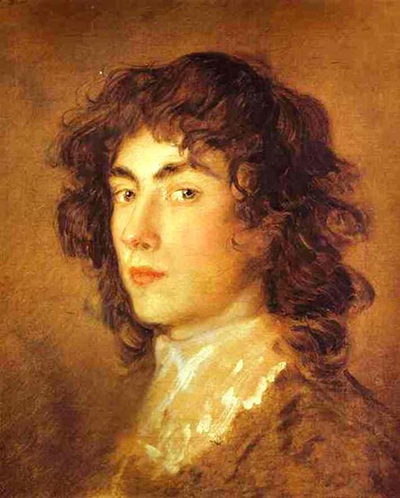This oil painting on canvas of a young man's head shot in profile looking directly at the painter depicts Gainsborough Dupont (1754-1797), thought to be painted between 1770-1775. Dupont was Thomas Gainsborough's nephew (the son of his sister Sarah) and Gainsborough painted him numerous times.
He became Thomas Gainsborough's only known apprentice in 1772 and worked with him until his death in 1788. He became a respected British mezzotint engraver and artist, also renowned for his portrait work, rendered in a similar style to his uncle. This portrait is characteristic of Gainsborough's fast yet harmonious brush strokes using thinned paint. His technical proficiency is evident from the dexterous feathery brushstrokes creating lustrous curls around the face and the ethereal luminosity of the complexion, cleverly created by tiny highlights using translucent glaze.
Dupont is neither smiling nor frowning; he adopts a sightly unsure expression, looking directly at the painter. From what is known about Dupont, this expression aptly represents his diffident personality. Gainsborough's lively strokes also depict a fashionable lace collar in a somewhat sketchy fashion creating a poetic feel to the picture. At the time, Gainsborough's use of colour was considered innovative. He would use colours in the foreground that were historically considered only suitable for use in the background. This particular portrait is predominantly created using a palette of browns, white and pink.
Although Gainsborough was a prolific painter of portraits (having started at the tender age of ten), it is said that he much preferred the landscape paintings he created. These landscapes (thought to be inspired by Dutch artists' style) would in turn inspire famous English artists John Constable (1776-1837; considered the greatest landscape painter by many) and Romantic painter Joseph Mallord William Turner (1775-1851; renowned for his unrivalled use of light). His portrait style would also influence artists such as French neoclassical painter Jacques-Louis David (1748-1825). The painting was bequeathed to the Tate Britain by British nobility Helen Venetia Vincent, Viscountess D'Abernon, upon her death in 1954. A final note of interest is that Dupont Gainsborough was interred in the same tomb as Thomas Gainsborough at St Ann's Church, Kew, Surrey, England.




